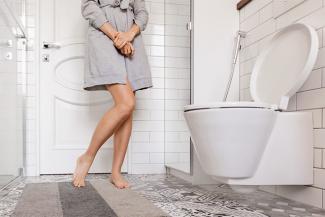
Urinary incontinence is a severely under-diagnosed and under-reported problem that increases with age. Dr. Ragini Agarwal Clinical Director-Obstetrics & Gynecology Minimal Access Surgery & Cosmetic Gynecologist of W Pratiksha Hospital Gurgaon answers common questions on management and treatment options
- Do you leak while sneezing laughing or coughing?
- Is your marital life affected?
- Have you started avoiding social gatherings?
Urinary incontinence is a severely under-diagnosed and under-reported problem that increases with age. It is twice as likely among females as males.
Q. What is urinary incontinence?
Involuntary loss of urine or urinary leakage is a common problem of pelvic floor disorder in females and sometimes in males too on sneezing, laughing or during exercises it can be few drops or may be a gush of urine.
In some person they cannot control urine if they feel sudden urge to pee.
Not a life-threatening disease, the condition is bothersome, embarrassing and undermines our self-confidence and freedom to enjoy life to its fullest. It affects 50- 84% of the elderly in long-term care facilities. Usually assumed to be a part of the normal aging process, many are unaware of how they can counter urinary incontinence. Modern medicine can help with incontinence and helps stay socially active
Q. What are the different types of urinary incontinence?
There are three main types:
Stress incontinence:
If you leak urine with laughing, sneezing, coughing or exercise, you may have stress incontinence. Stress incontinence is caused by weakness in the muscles and ligaments that support the bladder and urethra. This results in urine leakage with any "stress" or movement that puts pressure on the bladder.
Overactive bladder and urge incontinence:
When person cannot control urine on sudden urge and must rush to toilet is called urge incontinence. In these cases some neurological defect is found. Overactive bladder usually present as urge incontinence.
Mixed incontinence:
It has elements of both stress and urge incontinence, then you may have mixed incontinence. For example, you may experience urine leakage during exercise and also when you feel a strong urge. Mixed incontinence is very common. One can have predominance on other type and required mixed therapy.
Q. How is urinary incontinence diagnosed?
Your gynecologist who is trained in urology or a urologist will evaluate after asking pertinent questions regarding your urinary habits and examine you and subject you for few tests too.
TESTS
- Routine urine examination to rule out infection
- Bladder, kidneys and urethra Ultrasound
- Examination of inside of urethra and bladder by CYSTOSCOPE
- Study of function of bladder and urinary muscles- Urodynamics,
The cause of urinary incontinence will be determined on base of this.
Q. What are treatments are available for urinary incontinence?
Treatments depends upon severity of symptoms and type of incontinence.
Urge Incontinence
Usually does not require any surgery. Exclusion of co-existing diseases like diabetes, multiple sclerosis etc. is required.
The most effective way to treat is a combination of therapies.
Common therapies are
- Behavioral changes
- Biofeedback to learn control on pelvic muscles and pelvic floor exercise
- Nerve stimulations
- Botox injections in bladder wall
- Medications -In people with overactive bladder, muscles in the bladder wall contract at the wrong time. Anticholinergics drugs are being used to treat OAB & UI by blocking the nerve signals related to bladder muscle contractions.
Stress Incontinence
- Pelvic floor exercise known as Kegel exercise is an age old method
- Biofeedback and medications also has limited use in SUI.
- Pessary - This helps reposition the urethra to help reduce stress incontinence. It is inserted in vagina by health care provider
- Injection of bulking agent in tissue around urethra.
While these treatments can help many women, those with more serious cases of stress incontinence usually need surgery. Often, these procedures are minimally invasive and allow patients to go home the same day.
Q. What surgical treatments are available for urinary incontinence?
There are many type of surgeries available
Most common surgery for stress incontinence is the placement of a "sling" under the urethra where a mesh is placed through a small incision in the vagina which helps the urethra remain closed preventing involuntary urine leakage.
Bladder neck suspension is another operation, which also helps provide support for the urethra and the part of the bladder that connects to the urethra.
But all operations have some complications, require anesthesia and admission in hospital.
Q. Do we have any treatment for SUI (Stress Urinary Incontinence) which doesn't require operation.
A. Non surgical Laser treatment for SUI is now available where no operation is required. It is office procedure, no anesthesia, painless, and no down time.Here once a month laser shots is given in vagina near urethra and repeated once a month for 3 months; time duration is 15-20 minutes.

Dr. Ragini Agrawal is Director Medical Services for W Pratiksha Hospital and Clinical Director – Obstetrics, Gynecology, Minimal Access Surgery & Cosmetic Gynecologist in Gurgaon,Sector-56. Qualification: MBBS | MS | FICOG | FICMCH | Fellowship in Gynae Endoscopy (UK)
Contributed by W-Pratiksha Hospital










